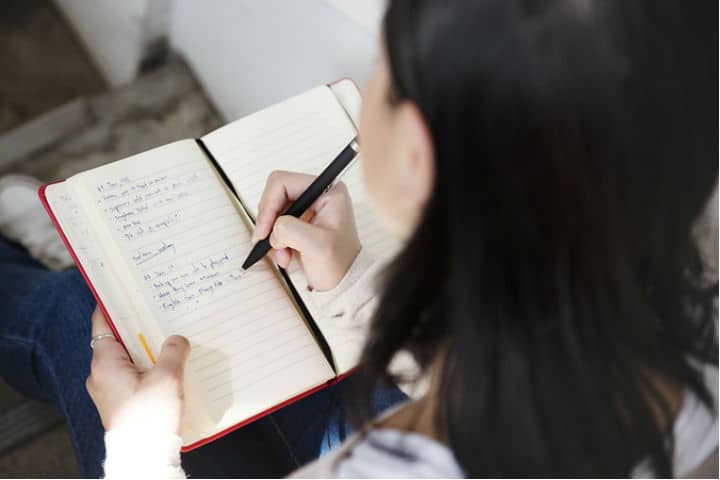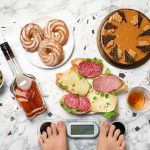Lynda: A few days ago I tried on my wedding dress only to find that I could barely do the zipper up. My initial reaction was to break into a sweat and think about all of the ways I could shed a few kilos before the big day in two months. The reaction that soon followed was something very different.
In my late teens I had anorexia. I hated who I was and what I looked like. I thought that by being skinny I would be desirable and happy. Fast-forward to “skinny me” and the reality was very different.
I still hated myself but in addition to this I hid myself away from family and friends, embarrassed about my skeletal frame. I became a recluse and a perfectionist. Needless to say I felt lifeless and depressed.
My mind was consumed with what my next meal was, how I could avoid eating, or where I could hide food so that I could throw it in the bin when I got the chance. I was petrified of food, eating, and weight gain. Sounds exhausting doesn’t it? Well, make no mistake, it was.
My anorexia was the story I wore until I finally decided that enough was enough. My so-called ideal weight and aesthetic had let me down.
In my mind, I was promised something that did not deliver, regardless of how militant I had been at sticking to my plan. I decided at my lowest and skinniest point to choose life and another kind of existence.
Gradually, I accepted invitations to go out with friends for a meal again. I reintroduced foods I had otherwise banned and began to experience a sense of genuine happiness again. I saw myself deserving of bigger things than the four bedroom walls and restricted foods I had confined myself to.
Close to 20 years later, instead of grieving the time lost, the torture felt, and the heartache I put loved ones through, I’m grateful for that experience. I now truly understand how food and social interaction provide information to nourish the body and stoke the fire of happiness.
Occasionally I am triggered and have found the old self wanting to return to destructive thoughts and behaviour. I short-circuit this with a few simple supportive tools. Many of these are a daily practice so that the old self remains a weak memory.
1. Emotional Freedom Technique (EFT)
EFT has been a big part of my healing journey and continues to be. EFT involves tapping on acupressure points while focusing on an issue, memory, or emotional challenge that you wish to clear.
Disordered eating is rarely driven only by a desire to look a certain way. My drivers for that kind of control with food was from poor self-worth, lack of self-love, and acceptance.
To this day, EFT continues to break through these old self-limiting and destructive beliefs. I work with an EFT practitioner and use it at home on my own when triggered. Learn more about EFT in this article I wrote recently.
2. Journaling
Journaling has been a game-changer for me. It’s been a platform to regurgitate negative thoughts and a space to express gratitude.
Lately it’s also been a powerful tool to write down small positive action steps. I journal almost every day, first thing in the morning. Sometimes it’s only a short sentence, and at other times it may be a page.
I use journaling solely as an outlet and rarely reread my entries. There are no rules with journaling. My style has changed throughout the years and no doubt will continue to. Find what works for you and forget the perfect grammar.
3. Gratitude
Having a gratitude practice means I fill up on the positive things in my life and even the things that I don’t have right now but want to embody. If what we focus our energy on expands, doesn’t it make sense to fill up on that which makes us smile or that which we want to create?
My gratitude practice also includes the benefit I get from that thing I am grateful for. For example, I am grateful for a day full of clients, which means I can pay the bills and continue doing what I love, help people achieve their health goals (or regulate their bowel movements).
If it’s something that you want to embody, you may say, “I am grateful for this pain-free body.” Or, as philosopher Henry David Thoreau would say, “I stand in awe of my body.”
I write my three gratitudes down or say them out loud. In addition to this, I announce something I’m grateful for in my day to my partner just before we sleep, as does he.
Fill up on gratitude and there will be less room for excessive worry. This investment may take as little as one minute of your time.
“If you change the way you look at things, the things you look at change.” — Wayne Dyer
4. Talking About It
When I try to deal with worries on my own, I ruminate on them for a number of weeks, sometimes months. However, when I express my thoughts and feelings to someone I trust, it helps me move through the concern much faster.
In the past, I would never talk about my negative thoughts for fear that I would give it energy and it would become part of my identity. Or I was simply ashamed of them. As a result I distanced myself from many people because I found it hard to be present. My mind was in constant overdrive, obsessing about my concerns.
It just makes sense to release the valve of our minds and let the worry out. It’s all part of how we process, how we manufacture. You have a thought, you express it, it leaves the body and makes more room for the new.
We are not our thoughts, but if we hold on to them, lock them in our minds and into the cells of our body, they do become a part of us. They may even express as an illness. Being vulnerable is often uncomfortable but has never been an action I have regretted. In fact, my strongest, most rewarding relationships have been built on vulnerability.
“What happens when people open their hearts? They get better.” — Haruki Murakami
5. Social Interaction
It’s important not to spend too much time mulling over self-destructive thoughts. I avoid dwelling by regularly attending social events such as networking groups, workshops, meal dates with friends, or I pick up the phone and call a buddy — even if every fiber of my being wants to hibernate.
These interactions and exchange of conversation reduce the amount of time I spend alone with my thoughts. People have been a huge part of my healing, whether they were aware of it or not. I aim for at least one social engagement a week.
6. Having a Purpose
I help people correct poor gut health. This purpose moves the focus and fixation from myself to the mission I am driven to deliver.
As a result, my worries seem less important because my energy isn’t tied up in it. I like to schedule and plan most of my days well so that hours are not spent entertaining obsessive, negative thoughts.
It feels really rewarding to help others. In fact, studies show that acts of generosity and kindness make for a happier, healthier person. Want some inspiration? Read Viktor Frankl’s fantastic book, Man’s Search for Meaning.
“Life is never made unbearable by circumstances, but only by lack of meaning and purpose.” — Viktor E. Frankl
7. Avoiding Fasting
Starving and depriving my body gave me an unhealthy, false sense of power and control. This deepened my fear of eating food and led to a deep depression.
Now, I take every opportunity, with every meal, to eat food I believe will nourish me. Food that I enjoy. Food I am grateful for.
Fasting may have its place for some people, but for me, it doesn’t feel supportive of my continued recovery. In fact, it leads to a mind consumed by thoughts of food and mindlessly overeating at my next meal.
If I’m in a situation like being on a plane or in a hotel where I don’t have access to good food, I often bring my own, pack a super-simple smoothie or moderately undereat to avoid going without.
Put simply, going without affects my mental health.
8. Finding Inspiration
Books, podcasts, TEDx talks, and documentaries of people who have walked a similar path and have recovered have been welcome friends during my recovery.
Some of the memorable ones are Breaking the Habit of Being Yourself by Dr. Joe Dispenza, Finding Freedom in Facing Pain TEDx talk by Amy Dalton, Overcoming Your Addiction podcast by Dr. Lo with Amy Dalton, and The Gifts Of Imperfection by Brené Brown.
In order for recovery to “stick” I had to adopt an attitude of courage, persistence, and faith that there is another way of being. I also had to let go of the belief that I was alone, because the truth is, we are not alone. We never were.
A quote or mantra that has continually inspired me is “You are not stuck where you are unless you decide to be.” — Wayne Dyer
“Owning our story can be hard but not nearly as difficult as spending our lives running from it. Embracing our vulnerabilities is risky but not nearly as dangerous as giving up on love and belonging and joy — the experiences that make us the most vulnerable. Only when we are brave enough to explore the darkness will we discover the infinite power of our light.” — Brené Brown









